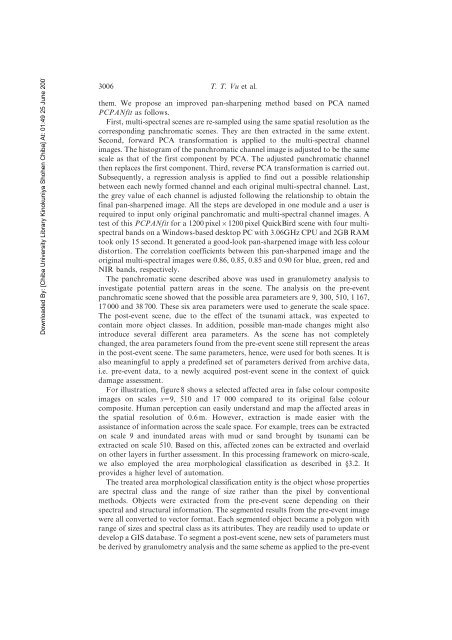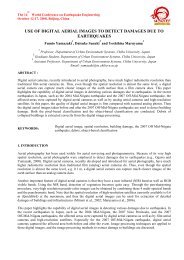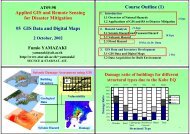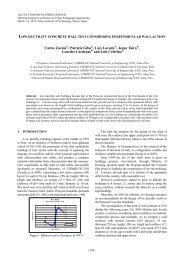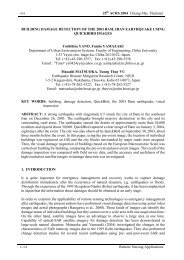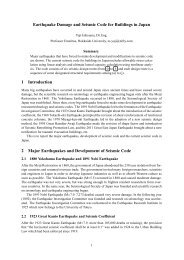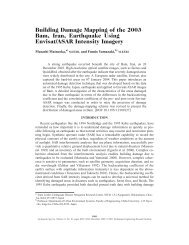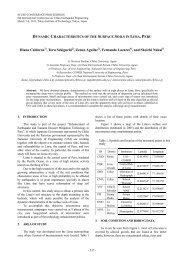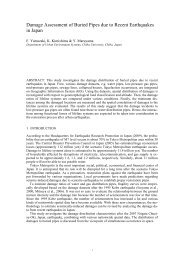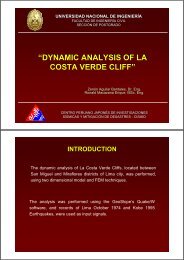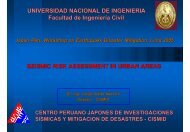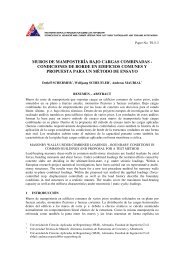Dual-scale approach for detection of tsunami-affected areas using ...
Dual-scale approach for detection of tsunami-affected areas using ...
Dual-scale approach for detection of tsunami-affected areas using ...
Create successful ePaper yourself
Turn your PDF publications into a flip-book with our unique Google optimized e-Paper software.
Downloaded By: [Chiba University Library Kinokuniya Shohen Chiba] At: 01:49 25 June 20073006 T. T. Vu et al.them. We propose an improved pan-sharpening method based on PCA namedPCPANfit as follows.First, multi-spectral scenes are re-sampled <strong>using</strong> the same spatial resolution as thecorresponding panchromatic scenes. They are then extracted in the same extent.Second, <strong>for</strong>ward PCA trans<strong>for</strong>mation is applied to the multi-spectral channelimages. The histogram <strong>of</strong> the panchromatic channel image is adjusted to be the same<strong>scale</strong> as that <strong>of</strong> the first component by PCA. The adjusted panchromatic channelthen replaces the first component. Third, reverse PCA trans<strong>for</strong>mation is carried out.Subsequently, a regression analysis is applied to find out a possible relationshipbetween each newly <strong>for</strong>med channel and each original multi-spectral channel. Last,the grey value <strong>of</strong> each channel is adjusted following the relationship to obtain thefinal pan-sharpened image. All the steps are developed in one module and a user isrequired to input only original panchromatic and multi-spectral channel images. Atest <strong>of</strong> this PCPANfit <strong>for</strong> a 1200 pixel61200 pixel QuickBird scene with four multispectralbands on a Windows-based desktop PC with 3.06GHz CPU and 2GB RAMtook only 15 second. It generated a good-look pan-sharpened image with less colourdistortion. The correlation coefficients between this pan-sharpened image and theoriginal multi-spectral images were 0.86, 0.85, 0.85 and 0.90 <strong>for</strong> blue, green, red andNIR bands, respectively.The panchromatic scene described above was used in granulometry analysis toinvestigate potential pattern <strong>areas</strong> in the scene. The analysis on the pre-eventpanchromatic scene showed that the possible area parameters are 9, 300, 510, 1 167,17 000 and 38 700. These six area parameters were used to generate the <strong>scale</strong> space.The post-event scene, due to the effect <strong>of</strong> the <strong>tsunami</strong> attack, was expected tocontain more object classes. In addition, possible man-made changes might alsointroduce several different area parameters. As the scene has not completelychanged, the area parameters found from the pre-event scene still represent the <strong>areas</strong>in the post-event scene. The same parameters, hence, were used <strong>for</strong> both scenes. It isalso meaningful to apply a predefined set <strong>of</strong> parameters derived from archive data,i.e. pre-event data, to a newly acquired post-event scene in the context <strong>of</strong> quickdamage assessment.For illustration, figure 8 shows a selected <strong>affected</strong> area in false colour compositeimages on <strong>scale</strong>s s59, 510 and 17 000 compared to its original false colourcomposite. Human perception can easily understand and map the <strong>affected</strong> <strong>areas</strong> inthe spatial resolution <strong>of</strong> 0.6 m. However, extraction is made easier with theassistance <strong>of</strong> in<strong>for</strong>mation across the <strong>scale</strong> space. For example, trees can be extractedon <strong>scale</strong> 9 and inundated <strong>areas</strong> with mud or sand brought by <strong>tsunami</strong> can beextracted on <strong>scale</strong> 510. Based on this, <strong>affected</strong> zones can be extracted and overlaidon other layers in further assessment. In this processing framework on micro-<strong>scale</strong>,we also employed the area morphological classification as described in §3.2. Itprovides a higher level <strong>of</strong> automation.The treated area morphological classification entity is the object whose propertiesare spectral class and the range <strong>of</strong> size rather than the pixel by conventionalmethods. Objects were extracted from the pre-event scene depending on theirspectral and structural in<strong>for</strong>mation. The segmented results from the pre-event imagewere all converted to vector <strong>for</strong>mat. Each segmented object became a polygon withrange <strong>of</strong> sizes and spectral class as its attributes. They are readily used to update ordevelop a GIS database. To segment a post-event scene, new sets <strong>of</strong> parameters mustbe derived by granulometry analysis and the same scheme as applied to the pre-event


